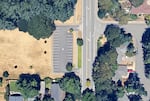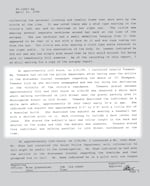Around 4:30 a.m. on Friday, March 20, 1998, Johnny Shattuck sat up in bed, awoken by “yelling and screaming.”
Hours later, investigators from the Salem Police Department arrived at the rundown house at the corner of 12th Street and Shamrock Drive where Shattuck lived and gathered statements from him and Shirley Williams, who lived in an upstairs apartment. On the first floor of the home, the landlord had found the body of Harriet Thompson amid a gruesome murder scene.
Detective Craig Stoelk wrote in a report that Shattuck “heard the words ‘Help’ and ‘Help me’ at various times.” He and Williams initially thought the noises were coming from their young children, but when Shattuck got out of bed to investigate the sounds, he realized “the noise was coming from downstairs.” When the yelling stopped, the couple went back to bed and did not call police.

An overhead view of the parking lot just north of the home where Harriet Thompson was killed in March 1998. Former newspaper carrier Janelle Tomason told OPB she was in this parking lot when she saw a white man running north along 12th Street southeast around the time of the murder.
Maps Data: Google Earth
This interview was critical: An early lead that allowed the detectives to pinpoint the time of Thompson’s killing to between 4 and 4:30 a.m.
But the leads quickly dried up; officers who fanned out across the neighborhood to gather information from neighbors didn’t find anyone in the vicinity of Thompson’s home who saw or heard anything directly related to the crime.
March 21 would bring new information. That morning, an article about Thompson’s slaying ran in The Salem Statesman-Journal, the local newspaper. Readers with information about what might have occurred were encouraged to call the case’s lead detective, Mike Quakenbush, directly.
Twenty-four hours after Thompson’s body was discovered, calls were coming in.
According to a report written by Det. Quakenbush, a Statesman-Journal delivery driver named Janelle Tomason called with information.
“She delivers newspapers and was out doing her deliveries in the vicinity of the victim’s residence,” Quakenbush wrote. Between 3:30 and 4 a.m. on the morning of the killing, Tomason “observed a white male adult walking northbound on 12th Street.”

A view of the north side of Harriet Thompson's home, taken from a gravel parking lot near Morningside Elementary School. Salem Statesman Journal newspaper carrier Janelle Tomason was in this parking lot facing this direction on March 20, 1998 when she saw a white man running away from Thompson's residence.
Documents obtained via public records request
Tomason gave a detailed description of who she saw: a 25- to 30-year-old white man of average height and muscular build, wearing a baseball hat and dark clothing, who had collar-length hair and an unkempt beard.

In a police report filed April 21,1998, Detective Mike Quakenbush documents information Janelle Tomason provided to the Salem Police Department. Tomason said she was working as a newspaper carrier at that time and was rolling papers in a parking lot next to the home where Harriet Thompson's murder took place. Tomason told police she saw a white man fleeing the area right around the time of the killing.
Documents obtained via public records request
Another tip came from John Shaw, a helicopter pilot with the Army National Guard.
Quakenbush wrote in his report that Shaw was driving to work on 12th Street between 6:20 and 6:30 a.m. on the morning of Thompson’s murder.
Shaw told Quakenbush that while driving by on 12th — a street that then had a speed limit of 40 mph — he saw a Black man in his 40s with a short afro wearing a denim work coat and acid-washed jeans. Shaw described the man “walking up and out of the bushes of the victim’s residence.”
Both of these callers — Tomason and Shaw — phoned on the same day with details relevant to the investigation, but each account was slightly off from the timeline given by the upstairs neighbor. Tomason recalled a white man running from the scene slightly too early if the murder occurred at 4:30; Shaw’s details about a Black man in the bushes would have been too late — up to two hours after the murder.
Even so, Quakenbush and his partner, Stoelk, only pursued further interviews with Shaw, according to their police reports.
“I made an appointment with Mr. Shaw to meet him out by the victim’s residence so he could show me specifically where he had seen this black male exit from the bushes,” Quakenbush wrote. He and Stoelk met Shaw at the house on 12th and Shamrock, and told him to walk them through what he observed on his drive to work.
“Mr. Shaw stated he was traveling northbound on 12th Street and was just south of the victim’s residence when he saw the black male walking in a west to east direction from the shrubbery,” Quakenbush reported. “Mr. Shaw indicated he has excellent vision, as he is a pilot.”
Quakenbush and Stoelk arrested Johnson on March 27, 1998, and seized several articles of his clothing, including a jacket.
While Quakenbush met with Shaw the day after the murder, he didn’t file his report detailing this meeting until a month afterward, on April 21, 1998 — long after Johnson was in jail facing charges for the Thompson killing.
“Mr. Shaw’s description of this black male adult’s clothing would come to closely resemble clothing that Detective Stoelk and I seized from Mr. Jesse Johnson later, as this investigation unfolded,” he wrote. “Mr. Johnson also matches the description of the individual that Mr. Shaw stated he observed leaving from the victim’s residence.”
The detectives focused on Johnson as the killer and, alongside Marion County prosecutors, developed a theory that he murdered Thompson for her jewelry. Shaw’s story supported that.
Tomason’s report did not.
Janelle Tomason — who has since married and changed her name to Janelle Osborne — told OPB that she clearly recalled that night outside Thompson’s apartment and her call to the Salem Police department with information. But she said she never received a call from Quakenbush or Stoelk.
“I clearly remembered seeing somebody run away from the house,” she said in an interview. “And I thought, ‘oh, that’s a little bit weird.’”
The next day, when she saw that police were seeking information about a murder, “I was like, ‘Oh, maybe I should report that I saw somebody leaving the area,’” she said. She called in her tip to the police but moved on after no one contacted her further.
In an interview, Quakenbush told OPB that despite what he wrote in his report about contacting Tomason, he also did not recall doing so. “I remember talking to the pilot,” he said. “I don’t remember talking to the newspaper person.”
After calling in her tip to the police, Tomason made another phone call: to her supervisor at the Statesman-Journal.
“After I had saw on the news that this girl was murdered, I was like, ‘No, I’m not going to do that over there anymore.’ And I had called my supervisor and I was like, ‘Hey, you need to get somebody else because I do not feel safe in that area anymore, because the person who did this saw me,’” she said.
Tomason’s description to OPB of that morning in 1998 departed significantly from what Quakenbush wrote in his report. She said the white man she saw that night was running, not waking, and described him as looking scared.
Still, when no one contacted her, Tomason forgot about the case. She did not follow the news of Johnson’s 2004 trial and conviction, did not know he had been sentenced to death, and had not heard of his sudden release in September 2023. When shown a photograph of Johnson, Tomason shook her head.
“It was not him. It wasn’t,” she said. “It’s so sad that somebody just lost 25 years of their life for something that they didn’t do, and for something that the police didn’t investigate very well.”
Prosecutors and Johnson’s attorneys both did not contact Tomason, and she was never called as a witness at Johnson’s trial.
John Shaw was.
At Johnson’s 2004 trial, Shaw was the third witness for the prosecution; he told his story about seeing a Black man emerge from the bushes.
“What was it about his face that you particularly noticed,” Marion County prosecutor Stephen Dingle asked Shaw.
“He seemed to have a fairly medium build, fairly thin,” Shaw said, “But he was — he was Black. And I just had not noticed any Black individuals in that neighborhood.”
Shaw told the courtroom that he met with the detectives on three occasions to talk about what he saw, and he was twice shown photo lineups of Black men. On neither occasion did he pick Johnson from the lineups.
Regardless, throughout the proceedings, prosecutors and detectives falsely implied that Shaw had pointed to Johnson as the man he saw coming from the bushes.
“This man, Mr. John Shaw, will tell you that the physical description of the man that he saw wearing this blue denim jacket and leaving the bushes matched the physical description of the defendant,” Marion County prosecutor Darin Tweedt said in his opening argument to the jury.
The defense argued against the connection, but did not sway the jury in the end.
“Suggesting that somehow or another Mr. Shaw has identified Jesse Johnson from this throwdown is ludicrous,” Noel Grefenson, one of Johnson’s attorneys, said in his closing statement. “It didn’t happen.”
Listen to all episodes of the “Hush” podcast here.